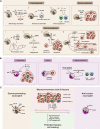Neutrophils in cancer carcinogenesis and metastasis
- PMID: 34674757
- PMCID: PMC8529570
- DOI: 10.1186/s13045-021-01187-y
Neutrophils in cancer carcinogenesis and metastasis
Abstract
In recent years, neutrophils have attracted increasing attention because of their cancer-promoting effects. An elevated neutrophil-to-lymphocyte ratio is considered a prognostic indicator for patients with cancer. Neutrophils are no longer regarded as innate immune cells with a single function, let alone bystanders in the pathological process of cancer. Their diversity and plasticity are being increasingly recognized. This review summarizes previous studies assessing the roles and mechanisms of neutrophils in cancer initiation, progression, metastasis and relapse. Although the findings are controversial, the fact that neutrophils play a dual role in promoting and suppressing cancer is undeniable. The plasticity of neutrophils allows them to adapt to different cancer microenvironments and exert different effects on cancer. Given the findings from our own research, we propose a reasonable hypothesis that neutrophils may be reprogrammed into a cancer-promoting state in the cancer microenvironment. This new perspective indicates that neutrophil reprogramming in the course of cancer treatment is a problem worthy of attention. Preventing or reversing the reprogramming of neutrophils may be a potential strategy for adjuvant cancer therapy.
Keywords: Cancer; Cell plasticity; Cell reprogramming; Microenvironment; Neutrophil.
© 2021. The Author(s).
Conflict of interest statement
The authors declare that they have no competing interests.
Figures

Similar articles
-
Neutrophils: important contributors to tumor progression and metastasis.Cancer Metastasis Rev. 2015 Dec;34(4):735-51. doi: 10.1007/s10555-015-9594-9. Cancer Metastasis Rev. 2015. PMID: 26361774 Review.
-
Neutrophils in Tumorigenesis: Missing Targets for Successful Next Generation Cancer Therapies?Int J Mol Sci. 2021 Jun 23;22(13):6744. doi: 10.3390/ijms22136744. Int J Mol Sci. 2021. PMID: 34201758 Free PMC article. Review.
-
Neutrophil dynamics in the tumor microenvironment.J Clin Invest. 2021 Mar 15;131(6):e143759. doi: 10.1172/JCI143759. J Clin Invest. 2021. PMID: 33720040 Free PMC article. Review.
-
Leveling Up the Controversial Role of Neutrophils in Cancer: When the Complexity Becomes Entangled.Cells. 2021 Sep 20;10(9):2486. doi: 10.3390/cells10092486. Cells. 2021. PMID: 34572138 Free PMC article. Review.
-
Roles of neutrophils in cancer growth and progression.J Leukoc Biol. 2018 Mar;103(3):457-464. doi: 10.1002/JLB.3MR0717-292R. Epub 2017 Dec 15. J Leukoc Biol. 2018. PMID: 29345348 Review.
Cited by
-
Lipids in the tumor microenvironment: immune modulation and metastasis.Front Oncol. 2024 Sep 26;14:1435480. doi: 10.3389/fonc.2024.1435480. eCollection 2024. Front Oncol. 2024. PMID: 39391242 Free PMC article. Review.
-
Integration analysis identifies MYBL1 as a novel immunotherapy biomarker affecting the immune microenvironment in clear cell renal cell carcinoma: Evidence based on machine learning and experiments.Front Immunol. 2022 Dec 14;13:1080403. doi: 10.3389/fimmu.2022.1080403. eCollection 2022. Front Immunol. 2022. PMID: 36591240 Free PMC article.
-
Anaplastic Lymphoma Kinase Inhibitor-Induced Neutropenia: A Systematic Review.Cancers (Basel). 2023 Oct 11;15(20):4940. doi: 10.3390/cancers15204940. Cancers (Basel). 2023. PMID: 37894307 Free PMC article. Review.
-
Liver metastasis from colorectal cancer: pathogenetic development, immune landscape of the tumour microenvironment and therapeutic approaches.J Exp Clin Cancer Res. 2023 Jul 22;42(1):177. doi: 10.1186/s13046-023-02729-7. J Exp Clin Cancer Res. 2023. PMID: 37480104 Free PMC article. Review.
-
A nomogram based on the preoperative neutrophil-to-lymphocyte ratio to distinguish sarcomatoid renal cell carcinoma from clear cell renal cell carcinoma.Front Oncol. 2023 Sep 22;13:1218280. doi: 10.3389/fonc.2023.1218280. eCollection 2023. Front Oncol. 2023. PMID: 37810969 Free PMC article.
References
-
- Drissen R, Buza-Vidas N, Woll P, Thongjuea S, Gambardella A, Giustacchini A, Mancini E, Zriwil A, Lutteropp M, Grover A, et al. Distinct myeloid progenitor-differentiation pathways identified through single-cell RNA sequencing. Nat Immunol. 2016;17(6):666–676. doi: 10.1038/ni.3412. - DOI - PMC - PubMed
-
- Kwok I, Becht E, Xia Y, Ng M, Teh YC, Tan L, Evrard M, Li JLY, Tran HTN, Tan Y, et al. Combinatorial Single-cell analyses of granulocyte-monocyte progenitor heterogeneity reveals an early uni-potent neutrophil progenitor. Immunity. 2020;53(2):303–318.e305. doi: 10.1016/j.immuni.2020.06.005. - DOI - PubMed
Publication types
MeSH terms
LinkOut - more resources
Full Text Sources
Medical

